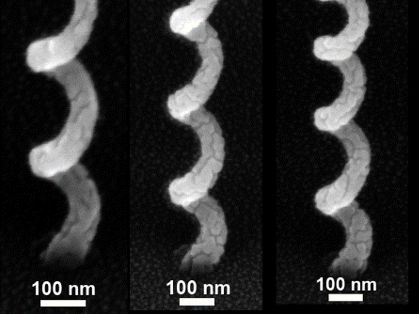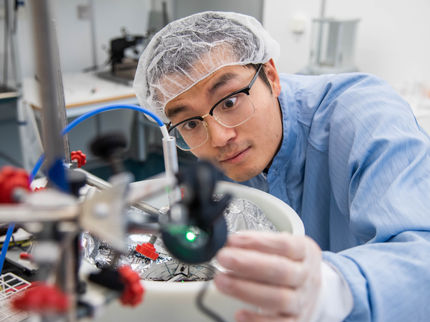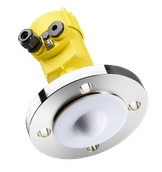Analytical tool designs corkscrew-shaped nano-antennae
Save time using maths
Advertisement
For the first time, an HZB team has derived analytically how corkscrew-shaped nano-antennas interact with light. The mathematical tool can be used to calculate the geometry that a nano-antenna must have for specific applications in sensor technology or information technology.

The nano-antennae werde produced in an electron microscope by direct electron-beam writing.
© HZB
The nanostructures from Katja Höflich's HZB team are shaped like corkscrews and made of silver. Mathematically, such a nano antenna can be regarded as an one-dimensional line that forms a helix, characterized by parameters such as diameter, length, number of turns per unit length, and handedness.
The nano corkscrews are highly sensitive to light: depending on frequency and polarisation, they can strongly enhance it. Because helical antennas have a handedness, they can select light quanta according to their handedness, i.e. their spin. This results in novel applications in information technology based on the spin quantum number of light. Another application may lay in sensor technology in detecting chiral molecular species down to the single molecule level.
Usually, the interaction of such nano-antennas with an electromagnetic field is determined using numerical methods. Each helix geometry, however, requires a new numerically expensive calculation.
For the first time, Höflich and her team have now derived an analytically exact solution of the problem. “We now have a formula that tells us how a nano-antenna with specific parameters responds to light”, says Höflich. This analytical description can be used as a design tool, as it specifies the required geometrical parameters of a nano-helix to amplify electromagnetic fields of desired frequencies or polarisation.
The HZB researchers were able to fabricate nano-antennae in an electron microscope by using direct electron-beam writing. The electron beam first writes a helix-shaped carbon structure one point at a time. This structure is subsequently coated with silver. The actual measurements of the optical properties for these silver nano-antennae are in good agreement with the calculated properties predicted by the analytical model.
Original publication
Other news from the department science
These products might interest you
Most read news
More news from our other portals
See the theme worlds for related content
Topic world Sensor technology
Sensor technology has revolutionized the chemical industry by providing accurate, timely and reliable data across a wide range of processes. From monitoring critical parameters in production lines to early detection of potential malfunctions or hazards, sensors are the silent sentinels that ensure quality, efficiency and safety.

Topic world Sensor technology
Sensor technology has revolutionized the chemical industry by providing accurate, timely and reliable data across a wide range of processes. From monitoring critical parameters in production lines to early detection of potential malfunctions or hazards, sensors are the silent sentinels that ensure quality, efficiency and safety.































































